The Sacramento River is the main river in northern California, flowing from the Klamath Mountains to San Francisco Bay. Its 400-mile course and most tributaries are heavily modified with several dams. They provide hydroelectric power and water to the surrounding areas.
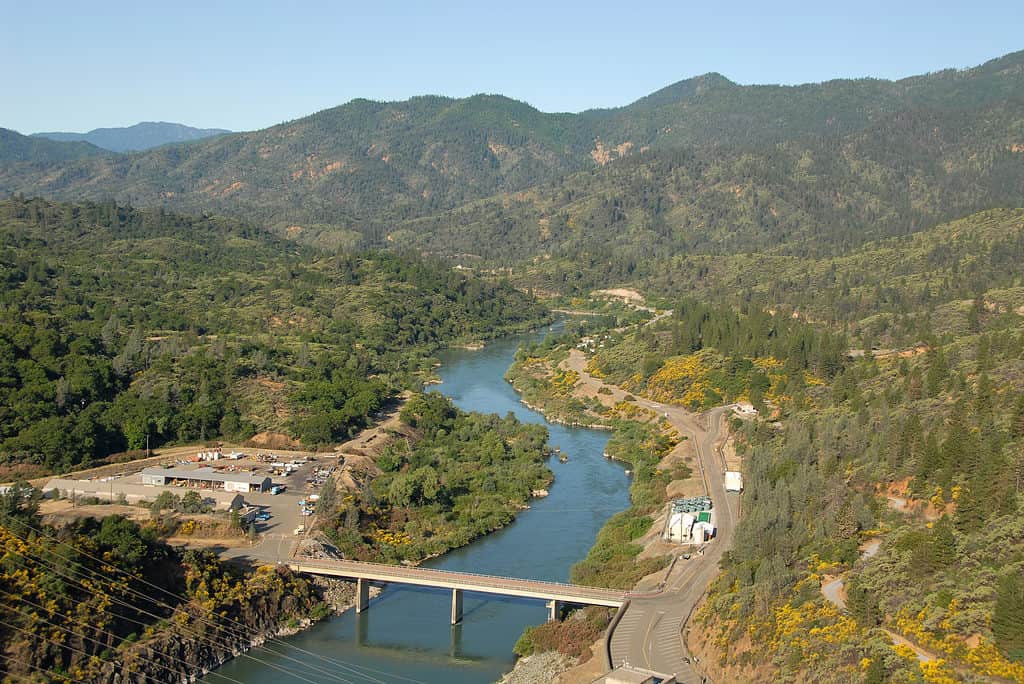
The Sacramento River has been heavily modified with dams placed on it and most of its tributaries.
©Hank Shiffman/Shutterstock.com
Although the fish population has changed dramatically and salmon runs are no longer as prolific, many animals still live around the Sacramento River. Snakes are a vital part of the environment and do more than most species to keep the rodent population in balance. Yes, they may be creepy or terrifying to some, but let’s explore! Here are a few of the more common snakes found around the Sacramento River.
Western Yellow-Bellied Racer (Coluber constrictor mormon)
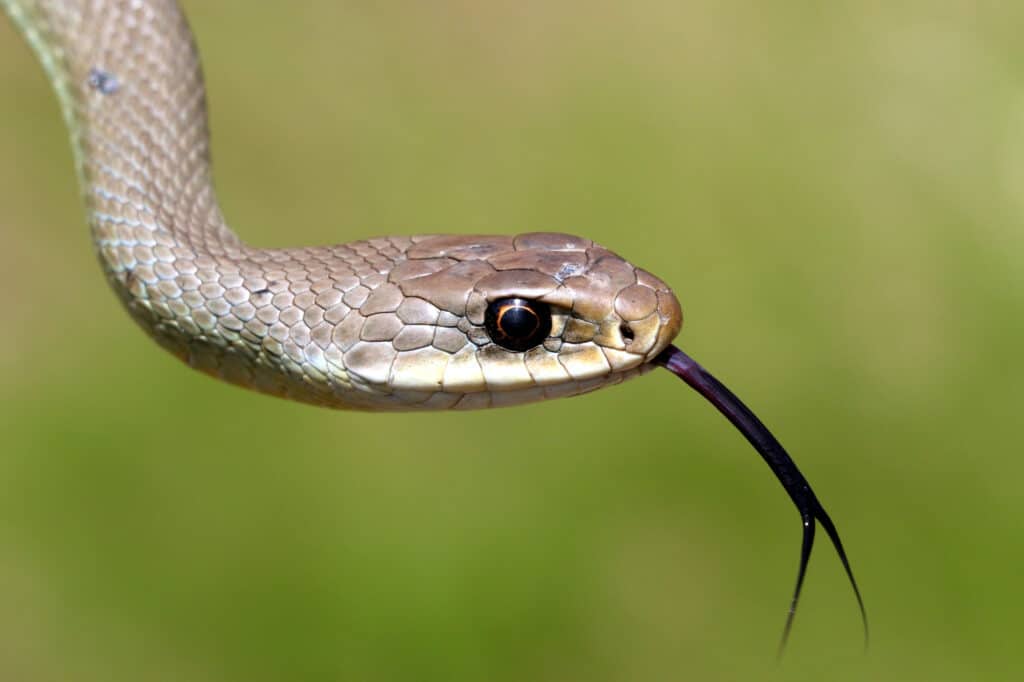
Western yellow-bellied racers sometimes eat venomous snakes.
©iStock.com/randimal
These fast-moving snakes are long and slender snakes that are most active during the day. Using their excellent vision, they track prey through grasslands, open forests, and scrubland. Western yellow-bellied racers can move at about four miles per hour, possibly faster at a sprint. Although that doesn’t sound very fast, that speed ensures they can catch their prey with relative ease.
Western yellow-bellied racers are a subspecies of North American racer, which is more of a catch-all for the various racers around the continent. Their main differences include location and adult color — behavior and habits are much the same.
Racers are generalists and eat just about anything they can overpower — rats, mice, insects, lizards, and sometimes other snakes. They are nonvenomous helpers that will bite repeatedly when cornered.
California Mountain Kingsnake (Lampropeltis zonata)

California mountain kingsnakes are often mistaken for venomous coral snakes due to their bold colors but do not live near coral snakes.
©Matt Jeppson/Shutterstock.com
One of several kingsnake species in California, the California mountain kingsnake is one of the prettiest. Its red, black, and white bands are strikingly beautiful sights when you are out looking for reptiles. Kingsnakes, like all snakes that have “king” in their name, regularly eat other snakes — including venomous rattlesnakes. They also eat a variety of small animals, including rats, mice, rabbits, and probably squirrels.
Although California mountain kingsnakes can get up to six feet long, most individuals you encounter will be in the two-and-a-half to three-and-a-half-foot range.
California Kingsnake (Lapmropeltis californiae)
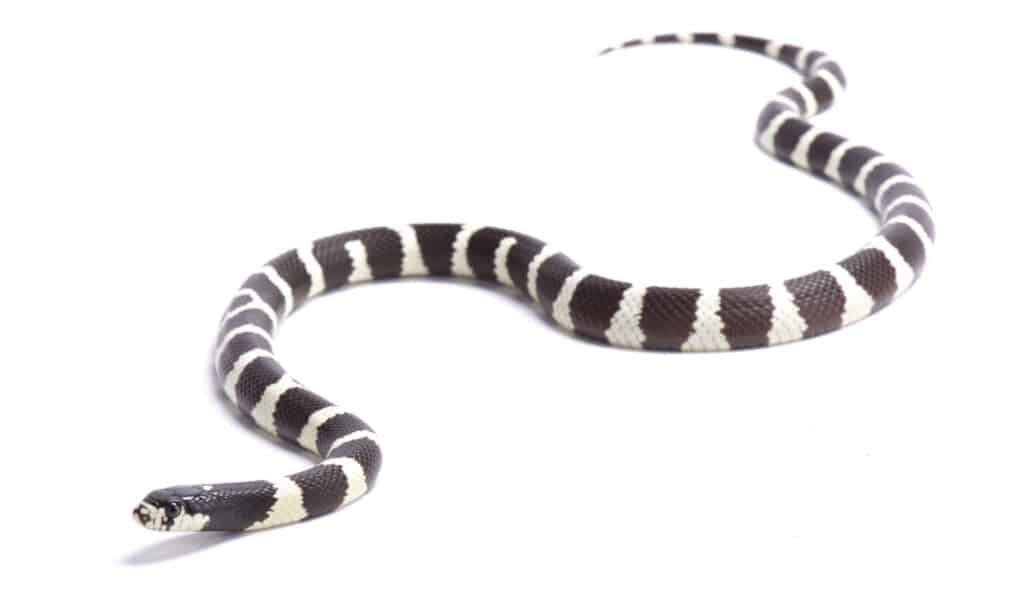
In the U.S., California kingsnakes average 2.5 to 3.5 feet long, but in Mexico, they may reach 5.5 feet.
©reptiles4all/Shutterstock.com
This species is usually black with narrow white bands, but they are extremely variable. Wild-caught California kingsnakes can be solid black, albino, leucistic, melanistic, and many other color combinations. Their natural tendency to spontaneously develop color morphs and their easy-going nature make them popular pets. During the 1970s, people captured many of these snakes and sold them as pets. While you would think this could damage the wild population, it did not harm this species. They are hardy and breed readily, so recovering from over-collection was possible.
Most California kingsnakes average two and a half to three and a half feet long, but they can grow to about six feet long.
Pacific Gopher Snake (Pituophis catenifer catenifer)

Pacific gopher snakes are nonvenomous but try to mimic rattlesnakes.
©Eric Isselee/Shutterstock.com
Several gopher snake subspecies roam the U.S. However, you are likely to find the Pacific gopher snake slithering around the Sacramento River. Gopher snakes are big and muscular, with a dramatic flair. When threatened, these snakes puff themselves up, mock strike, hiss loudly, and rattle their tail against the ground. However, their strikes are often with their mouths closed and they calm down the moment you pick them up.
Their patterns look similar to the local rattlesnakes, but they are not as bulky as the pit vipers. Pacific gopher snakes often reach six feet long, and sometimes get up to eight feet. These nonvenomous “farmer’s helpers” eat a vast quantity of rodents annually.
Aquatic Garter Snake (Thamnophis atratus)
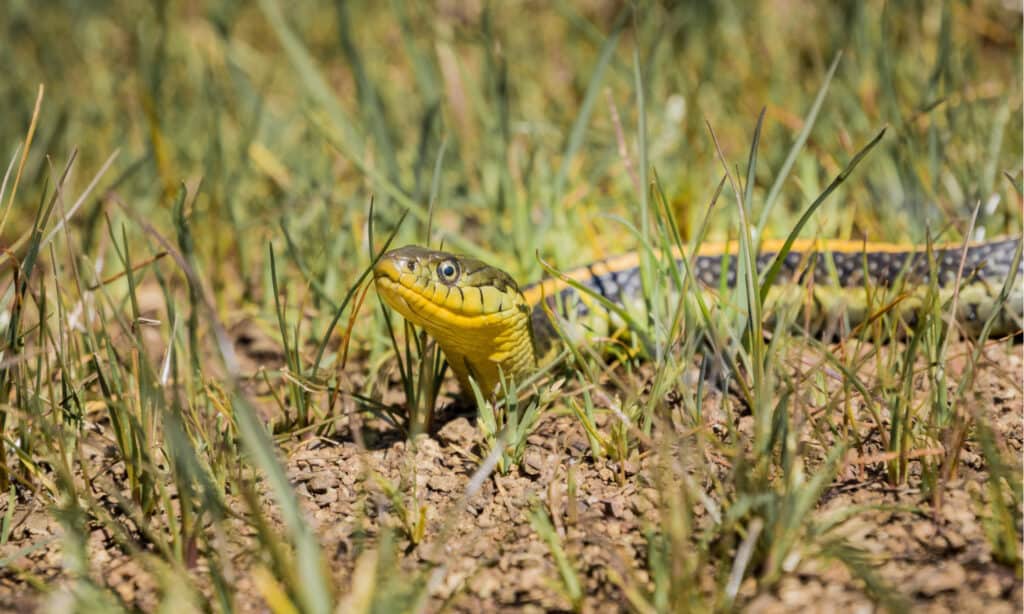
Aquatic garter snake basking in the sun on a hot day, in San Francisco Bay, California
©Sundry Photography/Shutterstock.com
This snake only occurs along the coast of California and Oregon. It looks similar to its cousins, except in some of its range it has a deep yellow dorsal stripe, and never has red pigment. Aquatic garter snakes eat fish, amphibians, tadpoles, and other small prey. They are more common in the San Francisco Bay area but might be found near the river’s source in the Klamath Mountains.
Western Terrestrial Garter Snake (Thamnophis elegans)
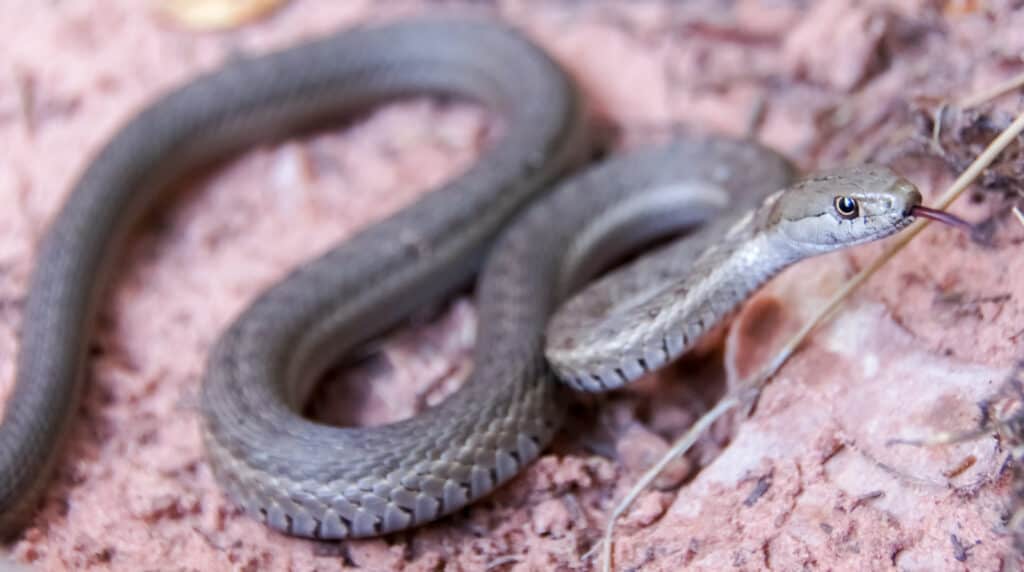
Western terrestrial garter snakes are found further away from water than other garter snakes.
©iStock.com/yhelfman
More land-tolerant than other garter snakes, western terrestrial garter snakes occur further from water. However, that doesn’t mean they are a fully terrestrial species. These snakes are just as capable in the water as their cousins, but far adaptable to life away from the water — something their diet reflects. Western terrestrial garter snakes are generalists and often eat whatever they can grab.
These snakes reach about three and a half feet long; some have red or black pots between their yellow, orange, or white dorsal and side stripes. Like other garter snakes, these are sometimes difficult to positively identify. However, they’re harmless unless you happen to be a bite-sized prey animal.
Giant Garter Snake (Thamnophis gigas)
Appropriately named, giant garter snakes look like normal garter snakes that somehow grew significantly bigger. These snakes grow over five feet long and have bright dorsal stripes like many other garter snakes. Their highly aquatic nature fits perfectly around the Sacramento River, but they’re rare — possibly the rarest of all garter snakes.
Giant garter snakes take full advantage of their watery landscape. Their diet includes fish, amphibians, and tadpoles, and these snakes take to the water as soon as the temperature reaches 78º Fahrenheit.
They’re more common further north along the Sacramento River but may be found near the river in the Central Valley.
Ring-Necked Snake (Diadophis punctatus)
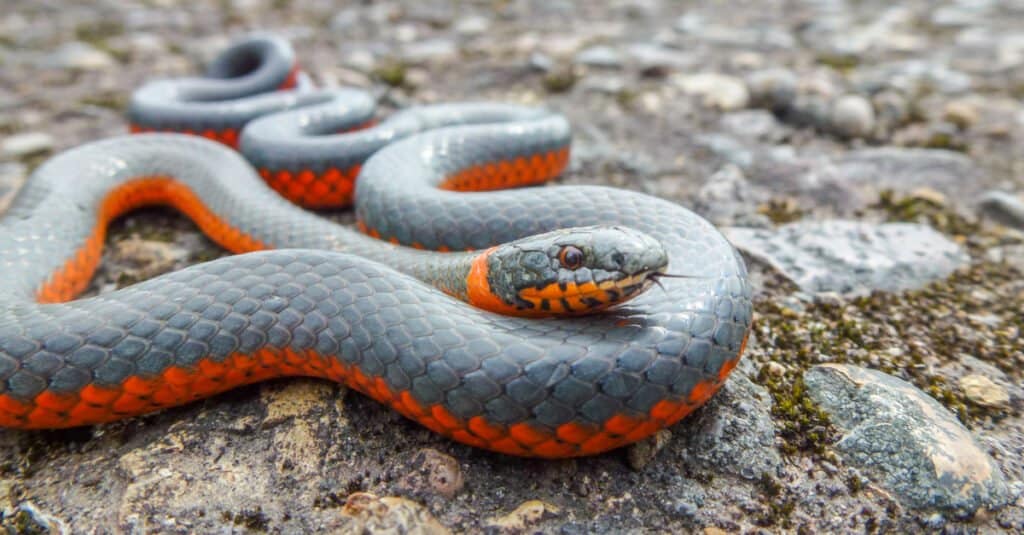
Harmless to people, ring-neck snakes are small snakes with a bright orange, yellow, or red belly color with a matching neck ring.
©Tom Fenske/Shutterstock.com
A small snake, ring-necked snakes often hide under moist leaf litter and debris, especially near the edges of rivers and ponds. These snakes eat small soft-bodied larvae, worms, and other arthropods, only rarely leaving their dark hiding places.
Ring-necked snakes have an olive to gray or black dorsal color, bright red, orange, or yellow ring around their neck, and matching belly color. They only grow up to about 15 inches long and are completely harmless.
Sharptailed Snake (Contia tenuis)

Their last tail vertebra forms a sort of spike that sharp-tailed snakes use to hold prey still.
©Bill Bouton / CC BY-SA 2.0 – License
This snake has a specialized tail that it uses to help trap prey — which happens to be small slugs and their eggs. Surprisingly long for such small prey, sharp-tailed snakes can grow up to 18 inches long! Their color is usually grayish brown to brick red, but other colors sometimes appear.
Are you still wondering about the tail? It’s the last tail vertebra that sticks out a little, giving the snake a spike to help grab prey.
Northern Rubber Boa (Charina bottae)
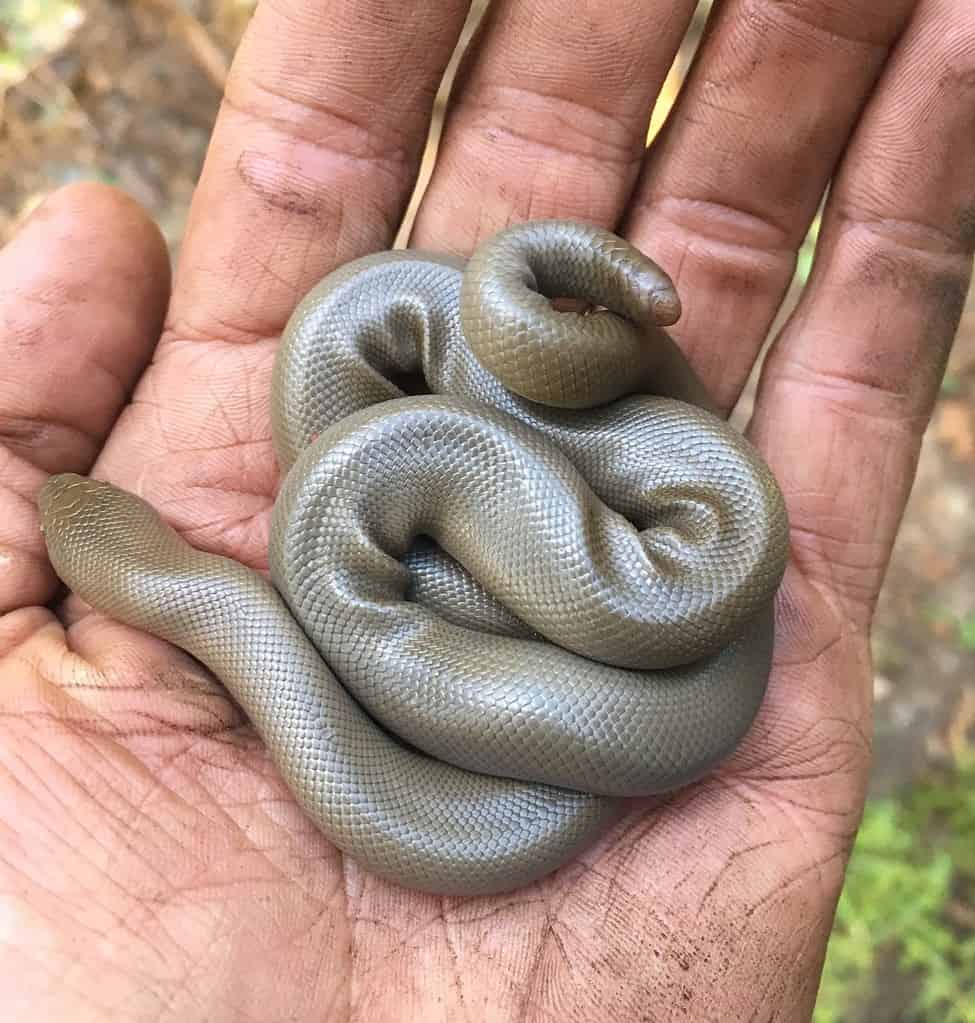
Their small shiny scales and loose skin give northern rubber boas a unique appearance.
©Matt Berger / CC BY 4.0 – License
If you love boas, we found one for you! Northern rubber boas live further north than any other boa species, even in southern Canada. We call them rubber boas because they have very small shiny scales and loose skin. In the sun, they look much like wet rubber.
These harmless snakes are usually a solid color that varies from brown to gray. Northern rubber boas are thick-bodied for their size and typically grow up to three feet long. You won’t see many of these snakes along the Sacramento River, not because they are rare, but because they are underground most of the time. This species is known for clearing out entire rodent burrows, by eating all the young while they fend off the parents.
This docile species is often used to help people afraid of snakes move past their fear. Northern rubber boas almost never bite, and are so calm that even wild individuals can be handled gently without issue.
Northern Pacific Rattlesnake (Crotalus oreganus)
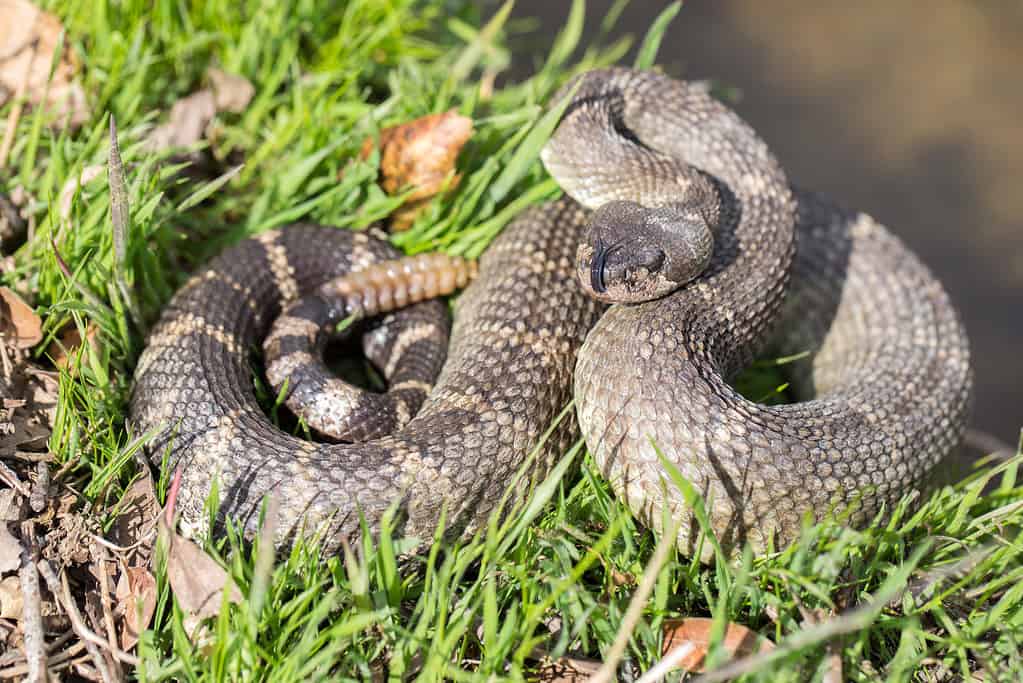
Northern Pacific rattlesnakes are the only venomous snake around the Sacramento River
©iStock.com/yhelfman
You aren’t likely to find any other rattlesnake species along the Sacramento River. A larger rattlesnake, the Northern Pacific rattlesnake can grow over five feet long — the record is five feet, four inches — but most individuals average three to three and a half feet. Like most of the western group of rattlesnakes, northern Pacific rattlesnakes have a dark stripe behind their eyes and banded tail ending in a rattle.
Northern Pacific rattlesnakes are more diurnal than most rattlers. Even so, they switch to early mornings and evenings if the summer is really hot. These snakes prefer grasslands and rocky outcrops for both shelter and hunting areas and often brumate with many other snakes in crevices and other cave-like openings. Some estimates say that rattlesnakes in general do more to reduce the rodent population than any other animal in North America. So although they should be admired from a distance, killing them should be a last resort.
Rattlesnake Bite First Aid
Although Northern Pacific rattlesnakes aren’t as nervous and edgy as western diamondback rattlers, they still bite when they feel threatened. These snakes typically give you a little more warning, but any rattler will strike if cornered, surprised, stepped on, or harassed.
Rattlesnake bites are rarely fatal, but they are medical emergencies. Luckily, you can do a few things to help minimize tissue damage. Here’s what to do if you are bitten by a rattlesnake:
- Stay calm and breathe. You’ll be able to keep a clear head.
- Call 911 or local rangers, or get to a hospital. California also has a toll-free phone number to call for poison control. Early treatment is vital to a full recovery.
- Immobilize the body part if possible and keep it below the heart’s level.
- Remove constrictive clothing and jewelry. If envenomated, you will swell up like a balloon.
- Take a photo or memorize details. However, in Northern California, you are only likely to encounter a northern Pacific rattlesnake. So, location is key.
Of course, we also need to know what not to do. So, here’s that list for you:
- Do NOT cut the bite wound and attempt to suck out the venom. It won’t work.
- Never try to catch the snake. If the first bite was a warning, the second will be for real.
- Do NOT use a tourniquet. They don’t work for rattlesnake venom and most people don’t know how to use them properly.
- Do not panic. There are only about five fatalities in the U.S. annually due to venomous snakebites.
- Don’t use ice. It won’t help you.
Other Animals Around the Sacramento River
The Sacramento River’s 400 miles includes some of the most beautiful terrain in the state of California. You can find everything from beavers to vultures in the Golden State, but here are several animals you can see around the Sacramento River.
- American Black Bear — The state bear is a frequent visitor to the Sacramento River.
- California Condor — once nearly extinct, they have made a come-back thanks to dedicated conservationists, including those at the San Diego Zoo.
- Arboreal Salamander — This tree-climbing, lungless salamander is nocturnal and extremely hard to catch.
Wildlife Sightings and Help
California has a reporting system for sightings of different species and situations. Visit their sightings page and select the link that applies.
- Wildlife incidents involving conflict, property damage, general sightings, and welfare.
- Dead wildlife
- Injured, sick, or orphaned animals
- Sightings of badgers, bats, elk, gray wolves, Sierra Nevada red fox, snowshoe hare.
The photo featured at the top of this post is © Hank Shiffman/Shutterstock.com
Discover the "Monster" Snake 5X Bigger than an Anaconda
Every day A-Z Animals sends out some of the most incredible facts in the world from our free newsletter. Want to discover the 10 most beautiful snakes in the world, a "snake island" where you're never more than 3 feet from danger, or a "monster" snake 5X larger than an anaconda? Then sign up right now and you'll start receiving our daily newsletter absolutely free.
Thank you for reading! Have some feedback for us? Contact the AZ Animals editorial team.






